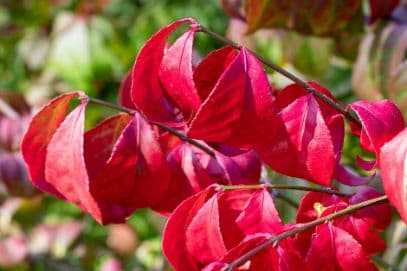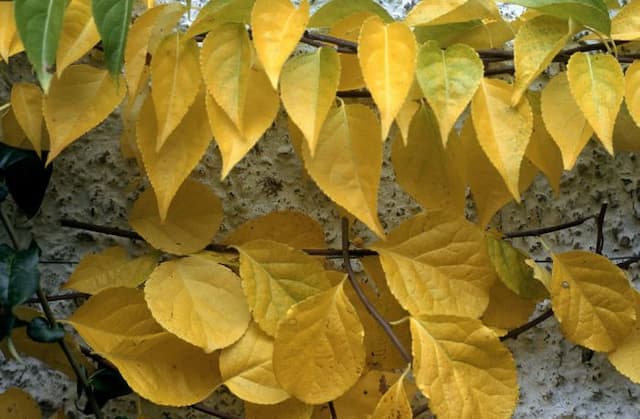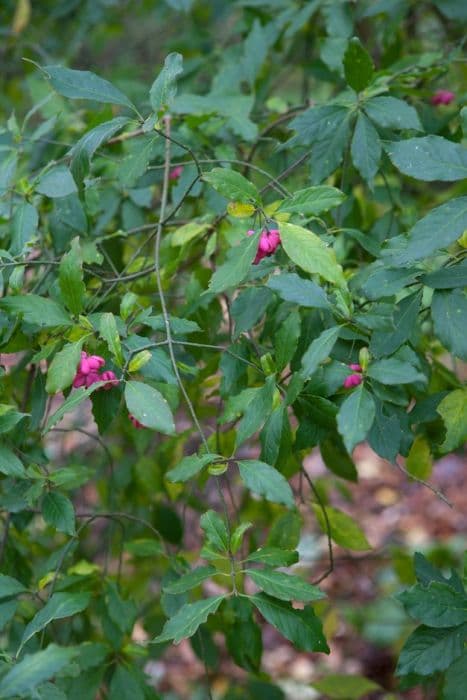Wintercreeper Euonymus fortunei 'Emerald 'n' Gold' (v)

ABOUT
The appearance of the Wintercreeper 'Emerald 'n' Gold' is quite distinctive and ornamental. This plant is characterized by its variegated leaves, which boast a vibrant combination of emerald green centers framed by bright golden yellow margins. The leaves are small and ovate to elliptical in shape, with a glossy texture that catches the light and adds luminosity to the plant's overall look. As a versatile ground cover, it often sports a dense, bushy habit with branches that can spread outwards. In cases where it has support, it may climb and exhibit a more upright growth. During the different seasons, the gold coloring of the leaves may take on a pinkish hue, especially in the cooler months, adding further visual interest. This variety of Wintercreeper produces small, inconspicuous flowers that may not be particularly eye-catching compared to its striking foliage. After flowering, it can form fruit, but these are not typically a significant feature in its appearance. Overall, the 'Emerald 'n' Gold' Wintercreeper's appealing color contrast and glossy leaves make it a favored choice for gardeners looking to create vivid, year-round interest in their garden spaces. Its ability to adapt to various growing conditions further enhances its ornamental value.
About this plant
 Names
NamesFamily
Celastraceae
Synonyms
Wintercreeper, Fortune's Spindle, Emerald 'n' Gold Euonymus, Gold-and-green Euonymus
Common names
Euonymus fortunei 'Emerald and Gold', Euonymus fortunei 'Emerald n Gold'
 Toxicity
ToxicityTo humans
Wintercreeper is considered toxic if ingested. The primary components causing toxicity are various alkaloids and compounds such as evonymoside found in the plant. If parts of Wintercreeper are eaten, symptoms of poisoning can include nausea, vomiting, abdominal pain, diarrhea, and weakness. Severe poisoning can potentially lead to more serious symptoms, but such cases are rare. It is important to seek medical advice if ingestion is suspected.
To pets
Wintercreeper is toxic to pets as well. The ingestion of this plant can cause symptoms similar to those seen in humans, including vomiting, diarrhea, abdominal pain, and weakness. More serious effects can occur depending on the amount consumed, and it is recommended to contact a veterinarian if a pet has ingested any part of the Wintercreeper plant.
 Characteristics
CharacteristicsLife cycle
Perennials
Foliage type
Evergreen
Color of leaves
Variegated
Height
2-3 feet (0.6-0.9 meters)
Spread
4-5 feet (1.2-1.5 meters)
Plant type
Shrub
Hardiness zones
5-9
Native area
China, Korea
Benefits
 General Benefits
General Benefits- Easy Maintenance: The Wintercreeper is known for its low maintenance requirements, making it a great choice for both experienced gardeners and beginners.
- Year-Round Interest: With its variegated gold and green foliage, Wintercreeper provides visual interest throughout all seasons, especially in winter when other plants might not be as vibrant.
- Soil Erosion Control: Its dense growth habit makes it effective in preventing soil erosion on slopes and banks.
- Versatile Landscaping: Wintercreeper can be used as ground cover, trained to climb walls or trellises, or even shaped into hedges and borders, offering great versatility in landscaping.
- Drought Tolerance: Once established, this plant is quite drought-tolerant, requiring minimal watering and thriving in a variety of conditions.
- Pest and Disease Resistance: The Wintercreeper is resistant to most pests and diseases, limiting the need for chemical treatments and making it a more sustainable choice for the garden.
 Medical Properties
Medical PropertiesThis plant is not used for medical purposes.
 Air-purifying Qualities
Air-purifying QualitiesThis plant is not specifically known for air purifying qualities.
 Other Uses
Other Uses- Winter Creeper can be used as a living mulch to cover bare ground, suppress weeds, and conserve soil moisture.
- In terrariums or bottle gardens, small cuttings of Winter Creeper can add a touch of variegated foliage and color contrast.
- As a topiary plant, it can be trained over frames to form various shapes for ornamental garden features.
- In creating garden mosaics or patterns, Winter Creeper can be used due to its colored leaves to create contrasting designs.
- It serves as a food source for certain types of wildlife, providing shelter and material for nest-building for small birds and insects.
- Landscape designers often utilize Winter Creeper in urban plantings due to its tolerance of pollution and compact growing habit.
- In coastal gardens, it can be effectively used to stabilize soil and reduce erosion due to its vigorous growth and hardiness.
- As an artistic medium, its colorful leaves can be utilized in leaf art projects or botanical collages.
- Winter Creeper can be employed in sensory gardens where its varying leaf textures contribute to tactile experiences.
- Its trailing growth habit makes it suitable for use in green walls and vertical garden installations to create living art pieces.
Interesting Facts
 Feng Shui
Feng ShuiWintercreeper is not used in Feng Shui practice.
 Plant Symbolism
Plant Symbolism- Fortune and Success: The plant's common name 'Fortune's spindle' and the cultivar name 'Emerald 'n' Gold' suggest a connection with wealth, prosperity, and success, symbolized by the golden and green colors.
- Versatility: Known for its ability to grow in various conditions, this plant represents adaptability and resilience in different environments.
- Boundary-Setting: Often used as a hedge, it symbolizes the ability to set boundaries and provide structure in one's life.
 Water
WaterWintercreeper should be watered deeply once a week during its growing season, particularly if the weather has been dry. It's best to water in the morning so that any water on the foliage can evaporate as the day warms up. One to two gallons per plant per watering should suffice, depending on the size of the plant and the environmental conditions. During the winter, reduce watering frequency as the plant's growth slows down and it requires less water. Make sure the soil is well-drained as Wintercreeper does not like to sit in waterlogged soil, which can cause root rot.
 Light
LightWintercreeper thrives best in a spot that receives full sun to partial shade. However, it can still grow in full shade, although its growth might be slower and its foliage color less vibrant. Ideally, place it where it can receive morning sunlight and dappled shade in the afternoon to protect it from intense heat, which it can tolerate but may not be ideal for the richest foliage color.
 Temperature
TemperatureWintercreeper is a hardy plant that can tolerate a wide range of temperatures, generally surviving in temperatures as low as -20 to -30 degrees Fahrenheit and as high as 90 degrees Fahrenheit. However, the ideal temperature conditions for its growth and vibrant coloration usually fall between 60 and 80 degrees Fahrenheit. Ensure to avoid planting it in areas prone to harsh wind or frost pockets, which can damage the plant in winter.
 Pruning
PruningPruning Wintercreeper is generally done to maintain shape, manage its size, or remove any damaged or diseased foliage. The best time to prune is in the late winter or early spring before new growth starts. Trim it as needed to keep the desired form or to prevent it from overgrowing its space. Light pruning can also be done during the growing season if you notice any irregular growth patterns or areas that need correction.
 Cleaning
CleaningAs needed
 Soil
SoilWintercreeper requires well-draining soil enriched with organic matter and a pH that is slightly acidic to neutral, ranging from 6.0 to 7.5. A good mix might contain garden soil, compost, and perlite or pine bark to ensure proper drainage and fertility.
 Repotting
RepottingWintercreeper is usually a vigorous plant that doesn't require frequent repotting. Repot every 2-3 years in spring to encourage growth and refresh the soil, or when you notice the roots are outgrowing the current container.
 Humidity & Misting
Humidity & MistingWintercreeper is tolerant of a range of humidity levels but does best in moderate humidity. It generally thrives in the typical ambient humidity found outdoors and can adapt to indoor conditions.
 Suitable locations
Suitable locationsIndoor
Provide bright indirect light and well-draining soil mix.
Outdoor
Plant in well-drained soil, partial to full sun exposure.
Hardiness zone
5-9 USDA
 Life cycle
Life cycleThe Wintercreeper 'Emerald 'n' Gold' starts its life as a seed, which when conditions are favorable, germinates and begins to grow roots and shoots. It develops into a young plant with characteristically variegated leaves of green and gold, which are evergreen and continue to photosynthesize year-round. As it matures, it forms a low-growing shrub with a creeping habit, spreading both horizontally and vertically if allowed to climb. It reaches reproductive maturity and produces inconspicuous, small greenish-yellow flowers, typically in early summer. If the flowers are pollinated, they will give rise to a small, pink to red fruit containing seeds, which, if dispersed, can lead to new plantings. Throughout its life, Euonymus fortunei 'Emerald 'n' Gold' can be pruned to maintain desired shape and size, and it may live for many years with proper care.
 Propogation
PropogationPropogation time
Spring to Summer
Propogation: The Euonymus fortunei 'Emerald 'n' Gold', commonly known as Wintercreeper, is typically propagated through semi-hardwood cuttings. This process is most successful when carried out during the late summer months. To propagate, healthy semi-hardwood stems are selected and cut into lengths of 4 to 6 inches (10 to 15 cm). The lower leaves are removed, and the cut end is often treated with a rooting hormone to stimulate root development. The prepared cutting is then planted in a pot containing a mix of peat and perlite, ensuring that the leaf nodes where roots will form are buried. The cutting needs to be kept moist and in a warm environment with indirect sunlight until roots have developed, which usually takes a few weeks. Once the cutting has established a robust root system, it can be transplanted into the garden or a more permanent container.







